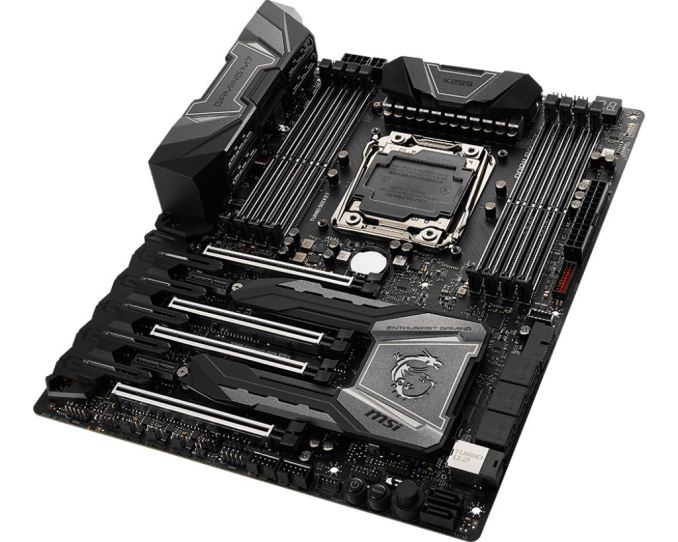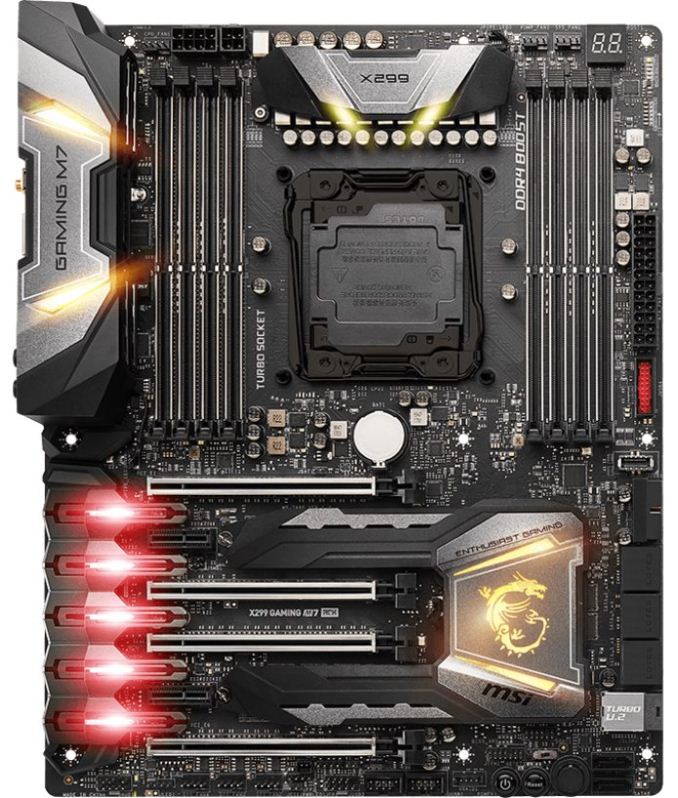The MSI X299 Gaming M7 ACK Motherboard Review: Light up the Night
by Joe Shields on March 5, 2018 10:00 AM EST- Posted in
- Motherboards
- MSI
- ATX
- M.2
- USB 3.1
- RGB
- X299
- Basin Falls
- Skylake-X
- Kaby Lake-X
- i9-7900X
Conclusion
Going in at the high-end of the motherboard offerings, on the high-end platform, suggests that a user wants and needs power - having a motherboard that can perform its duties becomes a vital asset. Most motherboards in the ecosystem now offer a good base level of design and performance, separated by the additions that each vendor applies for features, controllers, and styling. MSI has a few tricks up its sleeve, such as the design aspect of the board and its dual M.2 heatsink hinge arrangement, or the dual Realtek ALC1220 codecs, or its Live Update 6 software. Users looking for that super special hardware point, such as 10G ethernet, or Thunderbolt, will have to look at a price segment a bit higher, but for all else, MSI can satisfy the majority of its intended audience. In the end, the Gaming M7 ACK was intended to be a 'gaming' centric motherboard and, for all intents and purposes, it has accomplished that goal. It is a well-rounded board that can be attractive to almost any buyer.
MSI's RGB LED implementation on the M7 ACK is tastefully implemented, using a total of four zones to bring some light into the build. The RGB LEDs are all hidden under a translucent fitting, which gives the board the potential for a nice ambient glow when in use. MSI iterates that if LEDs are not in the user plan, then they can be disabled. But MSI's Mystic Light software allows for several different lighting effects as well as independent control in order to tweak the lighting.
There are a few bits that we'd like to see MSI address in the future, such as support for high-amperage fans, or a more gradual implementation of the auto-overclocking feature, and fixing the longer POST times of MSI motherboards to be in line with others.
Our performance testing has the M7 ACK sitting at the big table with the other boards showing that the MCE implementation is similar to the X299 boards we tested. Our overclocking adventures left us hitting the same 4.6 GHz speeds as we have seen most boards able to support. We expect this as we are of course limited by the choice of cooler. Also a positive is MSI's Click BIOS 5, which is one of the more ergonomic BIOSes around with most everything in one section or one level below.
Buy MSI X299 Gaming M7 ACK on Amazon.com
Overall, the MSI X299 Gaming M7 ACK is a very capable board. Its feature set is comparable to other boards in its price class. There are two other boards with U.2 ports in this price range: U.2 typically isn't a make or break feature considering its adoption, but it is always good to have. Choosing any board is going to come down to needed/wanted features, aesthetics, and price. The MSI Gaming M7 ACK, with its hinged M.2 heatsink cooling solution, is one of a kind at this price point and should help keep those hot running modules cool. Between the boards listed below, there really isn't a clear leader considering how close the pricing is, unless U.2 is a requirement for your build.
That said, the MSI X299 Gaming M7 ACK should be on the short list when looking for a motherboard in the $350-$400 price range as it presents users with a good base to build an X299 based machine.
Other AnandTech X299 Motherboard Reviews:
- The Intel Skylake-X Review: Core i9-7980XE and Core i9-7960X Tested
- The Intel Skylake-X Review: Core i9-7900X, i7-7820X and i7-7800X Tested
- The Intel Kaby Lake-X Review: Core i7-7740X and i5-7640X Tested
- Intel Announces Basin Falls: The New High-End Desktop Platform and X299 Chipset
- ($480) The ASUS Prime X299-Deluxe Review [link]
- ($400) The GIGABYTE X299 Gaming 7 Pro Review [link]
- ($390) The ASRock X299E-ITX/ac Review [link]
- ($390) The ASRock X299 Professional Gaming i9 Review [link]
- ($370) The ASUS Strix X299-XE Gaming Review [link]
- ($366) The MSI X299 Gaming M7 ACK Review (this review)
- ($308) The MSI X299 Gaming Pro Carbon Review [link]
- ($340) The ASUS X299 TUF Mark 1 Review [link]
- ($330) The EVGA X299 FTW-K Review [link]
- ($290) The EVGA X299 Micro Review [link]
- ($290) The ASRock X299 Taichi Review [link]
- ($260) The MSI X299 Tomahawk Arctic Review [link]
- ($232) The MSI X299 SLI Plus Review [link]
The MSI X299 Gaming M7 ACK is $366 at Amazon, but has a regular listed price of around $400-$420. At that price point, it will compete with boards in the $350-$400 range including the ASRock Fatal1ty X299 Professional Gaming i9 currently listed at $390, the ASUS ROG Strix X299-XE Gaming at $370, and the GIGABYTE X299 AORUS Ultra Gaming Pro priced at $350.












32 Comments
View All Comments
mkaibear - Monday, March 5, 2018 - link
>dual Realtek audio chipsHrm
>Killer based networking,
Pass
> and plenty of RGB LEDs to light up the case
Hard pass
CheapSushi - Monday, March 5, 2018 - link
Hating on Killer NICs has become a dumb meme. And guess what? The newer chips are often actual Intel. https://www.anandtech.com/show/12178/its-actually-...mkaibear - Monday, March 5, 2018 - link
I choose to "hate on them" because their USP is that they make the board somehow faster in online gaming, yet every independent test shows them to not do that - plus they increase the BOM significantly for no real benefit.The Killer chips on this board aren't Intel btw.
(There's a bit of personal history involved too - I've had several machines with Killer networking chips and they've all had significant driver problems)
nevcairiel - Tuesday, March 6, 2018 - link
Reputation is hard to fix, and if its just an Intel chip, whats the premium you get from those exactly?Personally I'll always prefer a board with plain Intel NICs, and WiFi on a PC board is meaningless to me anyway (the one you linked is Killer WiFi, not Ethernet)
Flunk - Tuesday, March 6, 2018 - link
Still a waste of money on that BoM and you get the annoying Killer app.Something being mentioned in a meme (and all memes are dumb), doesn't make it untrue.
Pork@III - Monday, March 5, 2018 - link
RGB LED give you +20 armor :D69369369 - Monday, March 5, 2018 - link
RGB LED give me erection :DPeachNCream - Monday, March 5, 2018 - link
Yet another x299 motherboard review of yet another yawn-fest RGB and Killer NIC been there and done that also ran gaming product. What's missing here is a non-standard approach and reviews up and down the product stacks of various vendors. This is what happens when you rely exclusively on what companies are willing to send you for free in the mail. They spoon feed journalists a series of gaming-class products with stupid features so we readers rarely see any decent analysis on the wider cost ranges of boards out there because poor people like Joe end up wasting their time messing with boards that only a small number of people purchase. The same thing happens with phones, processors, GPUs, and so forth.I'm sorry if this sounds rude, but it's frustrating and makes this Peach not overly fond of tech journalism at large. Add that to the years of touting Rivet Networks Killer products without ever justifying it with a benchmark or two that demonstrates there's a reason for the boosting writers have to do and it the whole site feels disappointing even if there's value in other articles. I mean there's not even a networking benchmark at all so we can't even infer added value by comparing a Killer whatever to vanilla Intel using results elsewhere. If the opening shots of the article are going to cite networking connectivity, why isn't that given even a cursory examination in the subsequent pages? What's going on Anandtech?
Ian Cutress - Monday, March 5, 2018 - link
Networking is extremely hard to get right as a test. It's easy to run it at peak speeds, but networks are rarely used in that instance.As for the marked benefit of Killer, it comes down to something not overly benchmarkable: online performance with concurrent data streams. If you are gaming, plus downloading, plus streaming, plus watching youtube on another monitor etc, the priority thing does its job. Most solutions are purely software-based - Killer's stuff is actually in hardware: for what isn't whitelisted, the packet analytics can work to decipher what sort of data is coming through, and from where: video, audio, direct downloads, torrents, and such all have detectable ways that the packet data is processed. Different codecs can have different packet profiles, and the Killer stuff is designed to detect them and adjust the return priority as appropriate. A packet will get tagged with a priority and sit in the incoming/outgoing queues, sometimes bypassing the queue altogether. Without deep networking knowledge, and hooks into the Killer hardware requirements, this is super difficult to benchmark. Unless you want a non-repeatable test with an uninterpretable result, or a repeatable test with no real-world value.
I'd love to get some proper Killer testing in, combined with an interview with the CEO and CTO. I can just tell from the comments that it would be a piece that people come just to comment negatively, rather than read, because of the Killer experience in the past. It's a topic I've discussed with the Killer team on numerous occasions.
As for the glut of X299 reviews, we have different reviewers for each chipset/socket: Joe on X299/Z370, Gavin on AM4, Tracy on TR4. Tracy has been waylayed due to lack of hardware, Gavin is new so getting up to speed, and Joe is powering through. Joe is only just moving to Z370 as well, and has a few of those already half-done.
timecop1818 - Monday, March 5, 2018 - link
> I'd love to get some proper Killer testing in, combined with an interview with the CEO and CTO.Why not actually do that? I would come to read it and laugh at the graphs showing killer not excelling at anything in particular.
I guess the reason there's not a killer nic review out there is because it would show how embarrassingly stupid the whole thing is, providing zero advantage at additional cost and actually making things worse by shitty drivers. I don't buy that QoS bullshit, Ian, you're not stupid, if some idiot is shittorenting on ADSL no amount of qos/killer is gonna make a difference when upstream is saturated. Most "gamers" that this is targeted at will either have appropriate broadband connection or be smart enough not to use bandwidth during their gaming sessions. Also with things like NAS etc having torrent/etc clients I just don't see many people using their primary gaming rig for downloading crap (or using shittorrent at all, i know i haven't for years).
I was looking at buying new XPS13 from Dell, saw it had soldered (not socket) killer WiFi, passed it for another brand.